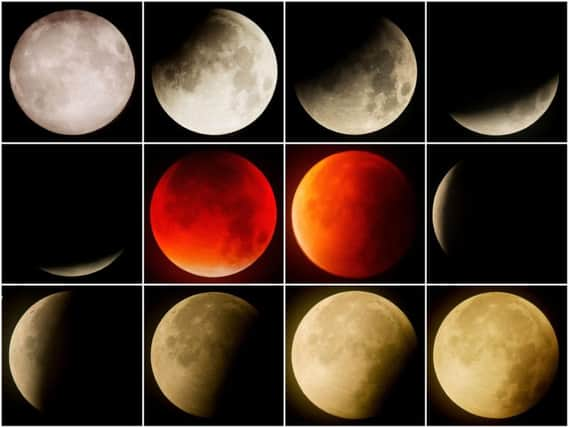'Blue moon' will put on a show for skygazers on Wednesday


Blue Moons are defined as the second full moon in a calendar month.
And this one will also be a supermoon, meaning the Earth's natural satellite will appear about 14% bigger and 30% brighter in the sky as it reaches its closest point to Earth.
Advertisement
Hide AdAdvertisement
Hide AdBut anyone in the British Isles hoping to see a lunar eclipse will have to jump on an aeroplane.
Dr Gregory Brown, an astronomer at the Royal Observatory Greenwich, said the moon will rise at about 5pm and will remain in the sky until 8am the following morning.
He said: "It will be high in the sky from about 19:00 and will be at its highest, and thus best, time at around 00:40.
"This coming full moon is unusual in that it is the second full moon of the month, when typically there is only one full moon per calendar month.
Advertisement
Hide AdAdvertisement
Hide Ad"Also, the full moon will be slightly larger than normal given that this is also a supermoon, so astrophotography will be more spectacular than normal."
But those expecting to see a lunar eclipse will be disappointed as Dr Brown says it will "definitely not be visible from the UK, not even a partial eclipse".
The eclipse, according to Nasa, will be "extra special" for those in the US and other parts of the world such as the Middle East, Asia, eastern Russia, Australia and New Zealand, where the Blue Moon will coincide with a total lunar eclipse.
Nasa said: "While the Moon is in the Earth's shadow it will take on a reddish tint, known as a 'blood moon'.
Advertisement
Hide AdAdvertisement
Hide Ad"With the total eclipse, it'll be a royal spectacle indeed: a 'super blue blood' Moon."
Wednesday's lunar phase fits the calendar definition of "blue" because there was another full moon on January 2.
The last Blue Moon occurred on July 31, 2015, and the next will be seen on March 31 this year.
Affelia Wibisono, also an astronomer at the Royal Observatory in Greenwich said: "March is expected to have two full moons, which, by the modern definition, means there will be two Blue Moons this year."
Advertisement
Hide AdAdvertisement
Hide AdTo make things more complicated, Blue Moon has also been defined as the third of four full moons in one season - which astronomers say is the traditional definition of the lunar phase.
Going by this interpretation, Wednesday's full moon is not blue at all. In fact, the next seasonal blue moon is not due until May 18, 2019.
Ms Wibisono said: "If we use the original meaning, then no, 2018 has no Blue Moons.
"There are three full moons between the winter solstice and the spring equinox (Jan 2, Jan 31 and March 2)."
For those keen to see a lunar eclipse in the British Isles, Dr Brown advises putting July 27 in the diary for "a more spectacular view" of the event.